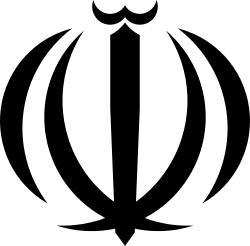Iran–Oman relations
 | |
Oman |
Iran |
|---|---|
Iran–Oman relations are bilateral relations between Oman and Iran. The two countries currently share diplomatic and economic ties dating back to the Pahlavi period. Oman considers Iran not to be a threat perceived by the other Arab states of the Persian Gulf. Both countries are members of the Organisation of Islamic Cooperation, the Non-Aligned Movement and the Group of 77. Iran has an embassy in Muscat whilst Oman has an embassy in Tehran.
Iran is situated across the narrow strategically-important Strait of Hormuz, to Oman in the south.
History
Pre-Islamic period
The northern half of Oman has been part of Maka (later Mazun), a satrapy of the Achaemenid Empire of Persia and later as vassal, under the rule of Al Julanda, to the Sasanian empire. [1][2]
Pahlavi dynasty
During the Pahlavi dynasty of Iran, the two countries had economic ties. During the Dhofar Rebellion in Oman, Mohammad Reza Shah, beside Britain, intervened in support of the Omani government.
Islamic Republic of Iran
The Baloch people who are ethnically an Iranian people and speak Balochi language (an Iranian language) are a significant minority, comprising approximately 25% of Oman's population. The majority of Iranians are Shia Muslims, while the majority of the Omani population are Ibadi.
Unlike the majority of its Gulf neighbours, Oman managed to uphold diplomatic relations with both sides during the Iran–Iraq War from 1980–1988 and strongly supported UN Security Council resolutions to end the conflict. Secret cease-fire talks between the two adversaries were held in Muscat during the war, and although an agreement was never reached during these talks, they did reduce distrust on both sides. Moreover, after the war, Oman mediated talks to restore diplomatic ties between Iran and Saudi Arabia and Iran and the United Kingdom.
During the Persian Gulf War, Iran–Oman relations were damaged after Iran began running attacks on tanker movements in the Persian Gulf and placed anti-ship missile launchers along the Strait of Hormuz. The Gulf neighbours have since restored their ties and have conducted joint military exercises as recently as February 2011.
Oman's leader Sultan Qaboos travelled to Iran in 2009 for the first time since Iran's 1979 Revolution. Though on two occasions the U.S. has dispatched high-level officials to discuss Iran with Oman, the fact that Oman has avoided publicly expressing any concerns regarding Iran's nuclear program is likely a reason why the two states have managed to maintain strong ties.
In addition to strong diplomatic and political ties, Iran and Oman cooperate economically on several fronts, including energy. Most recently, the Gulf neighbours signed an initial agreement to begin supplying large quantities of natural gas from Iran to Oman, a project that was earlier reported to be worth between $7–12 billion. In addition to these major economic projects, the two countries have opened a joint bank to facilitate their mutual financial dealings, agreed to develop the Kish and Hengam gas fields in the Persian Gulf, and signed a memorandum of understanding for a potential joint petrochemical project valued at $800 million.
In March 12, 2014, Iran sealed a deal to export 10 billion cubic meters of gas per year to Oman, an agreement involves building the subsea Iran–Oman pipeline across the Persian Gulf at a cost of about $1 billion. Oman agreed to buy gas from Iran as far back as 2005 and a later draft deal in 2007 included plans for Oman to process Iranian gas for export as liquefied natural gas (LNG), but the two sides had never finalized terms and Oman had been pressured by the United States to source fuel from alternative suppliers such as Qatar, according to US embassy cables released by WikiLeaks.[3][4]
Iran nuclear deal
The Iran–US secret talks became more serious in March as Barack Obama dispatched the deputy secretary of State William Burns and Vice President Biden's top foreign policy adviser Jake Sullivan together with five technical experts to meet with Iranian officials. Talks conducted over the nuclear issues, Iranian involvement in Syria, Tehran's threats to close the Strait of Hormuz and the status of Robert Levinson and two other Americans detained in Iran. In May, Secretary of State John Kerry visited Oman to make sure the channel would be kept open. After Rouhani was elected as the president of Iran, the final secret meeting was conducted with the American officials under chief US nuclear negotiator Wendy Sherman.[5]
After the deal, regarding Oman's role, President Rouhani said that Oman, not only hosted a number of important meetings, but also "played a critical role in getting these talks off the ground in the first place".[6]
Protecting power
From July 2012 to October 2013, all Iranian interests in the United Kingdom were maintained by the Omani embassy in London as a protecting power.[7]
See also
References
- ↑ electricpulp.com. "ʿARAB i. Arabs and Iran (pre-Islamic) – Encyclopaedia Iranica". www.iranicaonline.org. Retrieved 2017-08-01.
- ↑ electricpulp.com. "ARABIA ii. The Sasanians and Arabia – Encyclopaedia Iranica". www.iranicaonline.org. Retrieved 2017-08-01.
- ↑ "Iran says seals gas export deal with Oman". Reuters. 12 March 2014.
- ↑ http://www.2b1stconsulting.com/oman-and-iran-planned-gas-pipeline-across-strait-of-ormuz/
- ↑ "How the Iran deal was done". Usatoday.com. Retrieved 2017-07-29.
- ↑ "Archived copy". Archived from the original on 2015-07-25. Retrieved 2015-07-24.
- ↑ "Oman to represent Iran interests in UK". Press TV. Retrieved 11 July 2013.
External links
| Wikimedia Commons has media related to Iran–Oman relations. |
